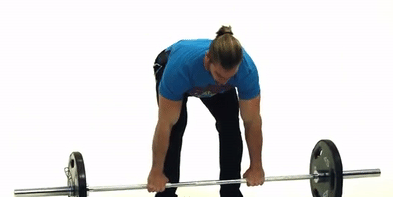The Pendlay Row is a back exercise invented by American weightlifting coach Glenn Pendlay. It is a variation on the barbell row, by which you train all muscle groups in your back. But how is Pendlay Row different and how does it benefit you?
DIFFERENCES
The Pendlay Row is similar to other horizontal rowing exercises insofar as it involves pulling a weight toward your body. The difference is that with the Pendlay Row, the weight (a barbell) starts and ends each repetition on the floor.
Pulling from a “dead stop” prevents you from using momentum to lift the weight, leaving your back muscles to do most of the work, says Pendlay. This version also helps you develop explosive power.
And with Pendlay Rows you train the middle and bottom of the trapezius a little more, a relatively difficult muscle region to train, which is important for creating back thickness.
PERFORMANCE
The correct execution of the Pendlay Row is as follows.
1. SET-UP
Stand in front of the barbell with your knees slightly bent. Place your feet shoulder-width apart, with your toes pointing slightly outward. Bend forward by moving your buttocks back. Grasp the bar slightly wider than shoulder width with an overhand grip (palms facing you). Straighten your back and lift your hips until your back is approximately parallel to the floor. Make sure you keep a straight back.
2. ROWING
Take a deep breath and tighten your abdominal muscles and glutes. Then pull the weight toward your upper body, touching it somewhere between your lower chest and belly button. When rowing, you pull your shoulder blades together.
3. DESCEND
While keeping your back straight and your core engaged, lower the bar to the floor. Do this in a controlled manner, but not too slowly: the entire descent takes 1 to 2 seconds or less.
Repeat this movement for the desired number of repetitions.
 The Pendlay Row. (Source: Buff Dudes)
The Pendlay Row. (Source: Buff Dudes)TIPS
Also pay attention to the following matters during implementation.
1. Don’t lift too heavy. Due to the stricter form of the Pendlay Row, you probably won’t be able to lift as much as you think. Choose a weight that allows you to perform the exercise correctly and in a controlled manner.
2. Tighten your core and pull your shoulder blades together so that your back remains in a neutral position.
3. Make sure your upper body is parallel to the floor after descending. So don’t ‘cheat’ by changing the angle of your upper body.
4. Keep your elbows in the right position. To ensure you work your back muscles, keep your elbows at a 45-degree angle to your torso during each repetition.
5. Don’t make the exercise easier by using your hips and legs. So do not use a so-called leg drive. The strength of Pendlay Row lies in its strict implementation.
6. Is this row variant still a bit too difficult for you? Then place the barbell with weights on an elevated surface. In this way you reduce the range of motion of the exercise.
NOT FOR EVERYONE
Due to the strict execution, Pendlay Rows are often found more difficult than regular rows, especially for people with limited hip mobility or a weak lower back. We therefore recommend that you only do the Pendlay Row once you have more training experience, in addition to the machine row, dumbbell row and/or barbell row. If you’re a brand new gym goer, start with the machine row. The Pendley is for later.
PROGRAMMING
An average natural bodybuilder needs between 10 and 20 sets per week for optimal back development. To do this, do two horizontal pulling exercises, the Panlay Row if desired, and another exercise, for example the machine dumbbell row. In addition, you do at least one horizontal pull exercise, such as the pull-up, twice a week depending on your weekly volume.
Cover image and extended demonstration: Jef Nippard.